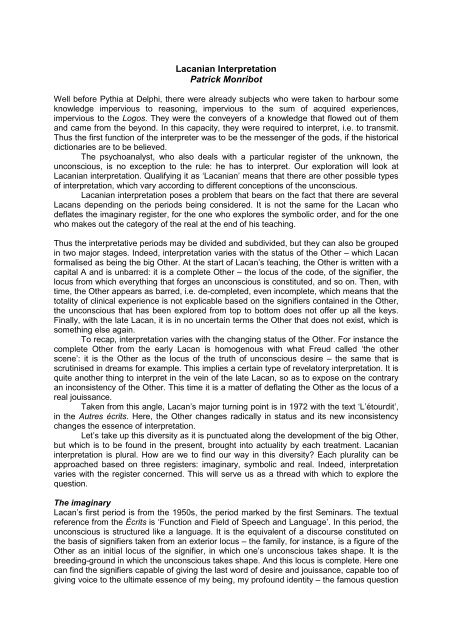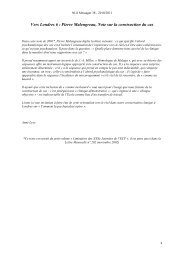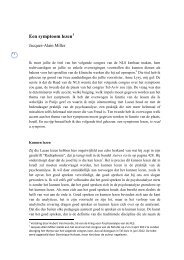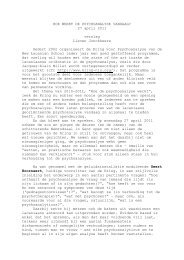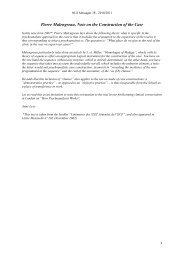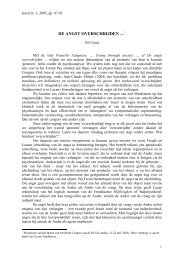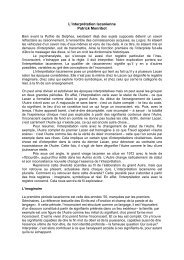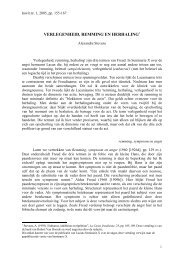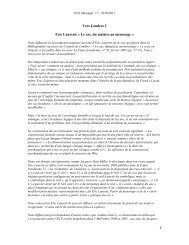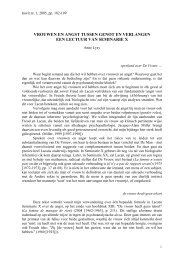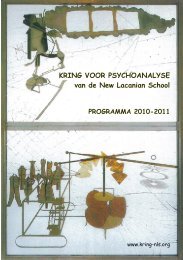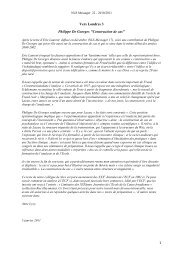Lacanian Interpretation Patrick Monribot - Psychoanalyse Lacan ...
Lacanian Interpretation Patrick Monribot - Psychoanalyse Lacan ...
Lacanian Interpretation Patrick Monribot - Psychoanalyse Lacan ...
Create successful ePaper yourself
Turn your PDF publications into a flip-book with our unique Google optimized e-Paper software.
<strong><strong>Lacan</strong>ian</strong> <strong>Interpretation</strong><br />
<strong>Patrick</strong> <strong>Monribot</strong><br />
Well before Pythia at Delphi, there were already subjects who were taken to harbour some<br />
knowledge impervious to reasoning, impervious to the sum of acquired experiences,<br />
impervious to the Logos. They were the conveyers of a knowledge that flowed out of them<br />
and came from the beyond. In this capacity, they were required to interpret, i.e. to transmit.<br />
Thus the first function of the interpreter was to be the messenger of the gods, if the historical<br />
dictionaries are to be believed.<br />
The psychoanalyst, who also deals with a particular register of the unknown, the<br />
unconscious, is no exception to the rule: he has to interpret. Our exploration will look at<br />
<strong><strong>Lacan</strong>ian</strong> interpretation. Qualifying it as ‘<strong><strong>Lacan</strong>ian</strong>’ means that there are other possible types<br />
of interpretation, which vary according to different conceptions of the unconscious.<br />
<strong><strong>Lacan</strong>ian</strong> interpretation poses a problem that bears on the fact that there are several<br />
<strong>Lacan</strong>s depending on the periods being considered. It is not the same for the <strong>Lacan</strong> who<br />
deflates the imaginary register, for the one who explores the symbolic order, and for the one<br />
who makes out the category of the real at the end of his teaching.<br />
Thus the interpretative periods may be divided and subdivided, but they can also be grouped<br />
in two major stages. Indeed, interpretation varies with the status of the Other – which <strong>Lacan</strong><br />
formalised as being the big Other. At the start of <strong>Lacan</strong>’s teaching, the Other is written with a<br />
capital A and is unbarred: it is a complete Other – the locus of the code, of the signifier, the<br />
locus from which everything that forges an unconscious is constituted, and so on. Then, with<br />
time, the Other appears as barred, i.e. de-completed, even incomplete, which means that the<br />
totality of clinical experience is not explicable based on the signifiers contained in the Other,<br />
the unconscious that has been explored from top to bottom does not offer up all the keys.<br />
Finally, with the late <strong>Lacan</strong>, it is in no uncertain terms the Other that does not exist, which is<br />
something else again.<br />
To recap, interpretation varies with the changing status of the Other. For instance the<br />
complete Other from the early <strong>Lacan</strong> is homogenous with what Freud called ‘the other<br />
scene’: it is the Other as the locus of the truth of unconscious desire – the same that is<br />
scrutinised in dreams for example. This implies a certain type of revelatory interpretation. It is<br />
quite another thing to interpret in the vein of the late <strong>Lacan</strong>, so as to expose on the contrary<br />
an inconsistency of the Other. This time it is a matter of deflating the Other as the locus of a<br />
real jouissance.<br />
Taken from this angle, <strong>Lacan</strong>’s major turning point is in 1972 with the text ‘L’étourdit’,<br />
in the Autres écrits. Here, the Other changes radically in status and its new inconsistency<br />
changes the essence of interpretation.<br />
Let’s take up this diversity as it is punctuated along the development of the big Other,<br />
but which is to be found in the present, brought into actuality by each treatment. <strong><strong>Lacan</strong>ian</strong><br />
interpretation is plural. How are we to find our way in this diversity? Each plurality can be<br />
approached based on three registers: imaginary, symbolic and real. Indeed, interpretation<br />
varies with the register concerned. This will serve us as a thread with which to explore the<br />
question.<br />
The imaginary<br />
<strong>Lacan</strong>’s first period is from the 1950s, the period marked by the first Seminars. The textual<br />
reference from the Écrits is ‘Function and Field of Speech and Language’. In this period, the<br />
unconscious is structured like a language. It is the equivalent of a discourse constituted on<br />
the basis of signifiers taken from an exterior locus – the family, for instance, is a figure of the<br />
Other as an initial locus of the signifier, in which one’s unconscious takes shape. It is the<br />
breeding-ground in which the unconscious takes shape. And this locus is complete. Here one<br />
can find the signifiers capable of giving the last word of desire and jouissance, capable too of<br />
giving voice to the ultimate essence of my being, my profound identity – the famous question
Who am I? To interpret is thus to contribute to the analysand gaining access to these<br />
signifiers, in so far as they elude him.<br />
The unconscious built up on the linguistic mode is one of <strong>Lacan</strong>’s finds designed to<br />
extract it from the imaginary. It is a question of dissociating the flow of clinical phenomena<br />
from the structure that organises them through interpretation. Clinical phenomena have a<br />
tendency to nudge the practitioner towards a psychological reading laden with all manner of<br />
meanings – in the style of ‘I’ll tell you why your daughter is dumb…’ In other words, clinicians<br />
are easily sucked into the imaginary register, which is where <strong>Lacan</strong> situates the cult of the<br />
‘how and why’ proper to introspective psychology, a long way off from psychoanalysis. The<br />
unconscious discovered by Freud obeys another logic. To demonstrate this logic, <strong>Lacan</strong><br />
examines the treatment as a dialectic. This is where the story of <strong><strong>Lacan</strong>ian</strong> interpretation<br />
begins.<br />
First of all, there was the Socratic dialectic in which the analyst positions himself in such a<br />
way as to allow a knowledge that has a truth-value to come about, following Socrates’<br />
example. This level of interpretation, directly below the imaginary, aims at re-establishing a<br />
lacuna in incomplete knowledge. It is a matter of filling in the holes of knowledge. In Book I of<br />
the Seminar, <strong>Lacan</strong> mentions in this respect the ‘patient historical reconstructions’ of Freud<br />
who ‘here proceeds as if […] with archival documents, employing textual criticism and<br />
exegesis.’1[1] For example: Freud reconstructs a copulation between the parents that his<br />
famous patient the Wolfman supposedly saw as a child – a scene reputed to be traumatic. It<br />
involved intercourse in the a tergo position.<br />
The analyst’s active constructions open the door onto a certain number of possible<br />
wayward paths, one of which, not the least of them, being that of proffering meaning to fill in<br />
the holes of knowledge. This is one way of straying off into introspective psychology. For<br />
example, in this vein, the analyst can reveal to the analysand the meaning of the<br />
transference by exposing the false liaison that the transference is – ‘I’m not who you think I<br />
am…’ This is an error! <strong>Lacan</strong> would say, quite rightly, that the transference is not to be<br />
interpreted – you don’t cut off the handy branch you’re sitting on with the analysand – rather<br />
you interpret ‘in’ the transference, which is quite different. More generally, the question of<br />
meaning opens up the debate on the difference between interpretation in psychotherapy and<br />
interpretation in applied psychoanalysis. J.-A. Miller put us on the right trail last year. For him,<br />
psychoanalysis aims wide-of-meaning whilst psychotherapy wallows in meaning.<br />
After Socratic dialectic, there was Hegelian dialectic. This time, the ends are different:<br />
it involves a problem of recognition. In the flow of the analysand’s words (free association)<br />
how is one to isolate full speech and get it to be recognised so that the subject’s true desire<br />
may be recognised? In this new approach, the imaginary axis is the one that fuels the waffle<br />
of empty speech and screens off the revelation of the truth, the latter being situated on the<br />
symbolic axis. Truth belongs entirely to the signifier in this period – the problem is one of how<br />
to say it. A leap has been taken. In the first dialectic, it was about revealing a lacunary<br />
knowledge. In the second, it is about revealing not a knowledge or history but full speech, a<br />
speech that would finally designate the subject’s Being. Full speech names Being – the<br />
subject’s Being, the Being of his true desire, the Being of his jouissance. It is quite different<br />
from the straightforward restitution of a fiction.<br />
What becomes of interpretation in this logic? <strong>Lacan</strong> turns it into something said by the<br />
analyst who occupies the place of full speech when it fails to arise on the side of the<br />
analysand. The analyst restores to the analysand-subject the responses of the Other, the<br />
signifiers of the Other that the subject lacks. The analyst is not really identified with the big<br />
Other but he is its intermediary. The symbolic axis is brought out from under the imaginary<br />
cape that cloaks it, by virtue of this dialectic in which the analyst recognises or furnishes full<br />
speech. We have got to the end of the fifties, and all that comes up against its limits fairly<br />
quickly. In 1958, in a text on ‘The Signification of the Phallus’, <strong>Lacan</strong> shows on the contrary<br />
the dead-end of the Hegelian dialectic: ultimately it fuels the imaginary axis more than it<br />
1[1] <strong>Lacan</strong>, J., The Seminar, Book I, Freud’s Papers on Technique, Norton, Cambridge, 1988, p. 189.
permits getting out of it – contrary to what <strong>Lacan</strong> had initially hoped. In the best cases, this<br />
satisfaction through recognition builds up the transferential alienation, which is not really the<br />
goal of analysis. Seen through to its end, the play of recognition between two speaking<br />
beings leads to a process of rivalry and confrontation – Hegel spoke of a ‘struggle to the<br />
death’ for ‘pure prestige’ regarding the master and the slave.<br />
It might be wondered what <strong>Lacan</strong>’s prescription was as far as interpretation was<br />
concerned during this so-called ‘dialectic’ period.<br />
One may observe a <strong>Lacan</strong> trying to extract his students from the post-Freudian<br />
current of interpretation conceived of as a meta-language. As J.-A. Miller has underlined, the<br />
IPA was putting forward an interpretative style of the meta-linguistic type. To put it simply: it<br />
amounts to reformulating what the analysand has just said – even what the unconscious has<br />
just interpreted, on occasion a dream for example – in a ‘better’ form. In an almost ‘echolalic’<br />
process, the analyst delivers to the analysand a metaphor of his Being: ‘You the analysand<br />
tell me “this is what I am” and I the analyst reply, “yes, thou art that”.’ This happened to me<br />
when I was starting out in my practice: a woman dreamt that her father, a wine lover, was<br />
driving while drunk and got stopped by the police but, curiously, she was the one that the<br />
judge fined. So, in the session I told her: ‘You are guilty of the jouissance of the father who<br />
drinks. That’s what your dream is saying.’ It was very true, but it was not a valid<br />
interpretation. She thanked me, gratefully, saying: ‘It’s great, you’re saying the same things<br />
as my dream is, but you sum it up so!’ I serve it her up in concentrated form and she is the<br />
one who interprets me. You can see that it is not an interpretation that counters the<br />
transference as it should, but an interpretation that reinforces it on its ideal and narcissistic<br />
side, an invention that fuels transferential alienation. It makes the consistency and<br />
completeness of the Other of the transference shimmer, the Other that can echo the<br />
unconscious. Fortunately, this interpretation did not have such harmful effects because I<br />
added the dimension of the act, suggesting raising the price of the session – since it was a<br />
question of paying for the fault in place of the father, better then to take it to the letter, in<br />
actuality if possible, before she pays the high price of the father’s fault in her life! On this<br />
score, she was less admiring, but I persisted, driving home my decision with a simple<br />
sentence: ‘Your dream is keeping count, let’s take account of that!’ It has to be said that she<br />
was paying dear for the father’s excessive jouissance by not allowing herself any success<br />
whatsoever in her life. Here, we left behind the meta-language prescribed by the IPA<br />
because there was an act along with an interpretation of her dream that was in the end<br />
laconic – keeping count is the writing of a ciphered quantity.<br />
The doctrine of full speech furnished a first move towards a solution to the dead-end<br />
of interpretative meta-language. Indeed, underlining full speech is not a simple redundant<br />
echo. It produces an effect of mutation on the side of Being. It is the famous ‘you are my wife’<br />
or ‘you are my master’ – the examples given by <strong>Lacan</strong> – that produce an effect on the one<br />
who utters and the one who receives this predicate.<br />
The whole question is one of knowing when to interpret, when to validate full speech<br />
under the proliferating mask of empty speech. When does the analyst come out of his<br />
silence? To take up one of <strong>Lacan</strong>’s syntagms: what is the interpretative ‘technique’? Well, it<br />
presupposes a strategy that consists in ‘playing the dummy’, as one says in bridge. Holding<br />
the place of the dummy amounts to freeing up a space for full speech. One detail however:<br />
playing the dummy does not mean being mortified in the face of the transference. That would<br />
be the silent version of the analyst advocated in the IPA where it is a matter of mastering the<br />
counter-transference as soon as it rears its head. For <strong>Lacan</strong>, it is a matter of playing the<br />
dummy at two levels. First of all, being careful not to intervene as a semblable, on the axis of<br />
interlocution. In other words: being careful to demarcate oneself from the specular relation<br />
that would position the analyst in a mirroring of the other – especially given that, in this<br />
period, the analytic bond is still being conceived of as intersubjective. Therefore, it is a matter<br />
of playing the dummy on the imaginary axis so as not to feed empty speech.<br />
Next, on the second level, it is a matter of playing the dummy as big Other. The<br />
analyst must not identify with the big Other, whom the analysand waits for so. Restoring the<br />
absent text of the big Other, contributing to it, is one thing; taking oneself for the embodiment
of the big Other is another. The analyst plays dummy on the symbolic axis so that the<br />
analysand can produce himself there by himself.<br />
Nevertheless, in moving out of the analytic relation of intersubjectivity, promoting full<br />
speech loses its pertinence. As of 1957 – the date of ‘The Instance of the Letter…’ – the<br />
symbolic is relieved, as it were, of the parasitic weight of the imaginary. It has found its full<br />
autonomy and interpretation changes in style: it is no longer a mere extraction of empty<br />
speech.<br />
The symbolic<br />
Here begins the major period of structuralism, the period of the unconscious structured like a<br />
language. The unconscious and the formations of the unconscious are regulated by<br />
metaphor and metonymy, organised by the laws of structure, which modifies the conception<br />
of interpretation. We come across the idea of relieving true desire of its mendacious gangue<br />
(in a nutshell: the symptom is a metaphor that keeps the truth of desire prisoner and<br />
misrecognised). To achieve this, it is a matter of un-knotting the symptom, namely, of<br />
deconstructing the formal and fantasmatic envelope that sketches out its shape. In a word, it<br />
is a matter of decoding the metaphor. To free desire of its metaphorical gangue is to give it<br />
back its possibility for metonymic drifting. It is to find again the permanent movement of libido<br />
that desire tries to translate. The truth of desire is thus nothing other than persisting on an<br />
inextinguishable course. It is no longer a matter of finding the last word that would give its<br />
ultimate signification. Desire is the ferret that is never done with running. <strong>Lacan</strong> says as<br />
much at the end of ‘The Instance of the Letter…’: ‘man’s desire is a metonymy.’2[2] And,<br />
need we remind ourselves, metonymy does not deliver up meaning.<br />
In other words, the truth expected of interpretation has changed status: it is no longer<br />
equivalent to a knowledge that would fix things down. The famous allegory mentioned by<br />
<strong>Lacan</strong> in ‘The Direction of the Treatment’ vouches for this: the one of the raised finger of St.<br />
John the Baptist painted by Leonardo da Vinci – a painting that hangs in the Louvre’s grande<br />
Galerie.3[3] As truth cannot be said, it can only be pointed at in an allusive way by an<br />
interpretative finger: the analyst’s finger which shows a direction, and not more. At this price,<br />
interpretation restores the sliding truth of desire without falling into the ‘bog’ of meaning and<br />
knowledge which would hamper its course. This freeing-up of desire with regard to meaning<br />
has its price: that of finding, at the end of the pointed finger, ‘the forsaken horizon of Being’,<br />
as <strong>Lacan</strong> tells us in this same text. Here, it is no longer a matter of restoring, by way of a few<br />
words, the missing part of the subject’s Being, a part that lies in waiting somewhere in the<br />
signifying belly of the Other. Far from it.<br />
The subject’s Being designated on the horizon by the pointing finger is a Being of<br />
jouissance (a) but certainly not a signifying formation. The Other of the symbolic thus starts<br />
to become inconsistent – we can find pretty much everything, but not the signifier that would<br />
say the Being of the subject. The result is that interpretation increases the subject’s want-of-<br />
Being because it merely underlines the indefectible riddle of his Being – the ‘forsaken horizon<br />
of Being’ is this too. In this sense, interpretation hystericises the subject to its paroxysm.<br />
Locating desire in this way as a horizon with no full-stop – making the Other deconsist<br />
– is a way of opening the door to the real. Such a conception brings us up against the<br />
impossibility of wording it, it brings us up against what eludes the Symbolic definitively – for<br />
example, the subject’s Being.<br />
What then is the mode of interpretation that <strong>Lacan</strong> advocates? It is multiple through<br />
its essence and through the effects aimed at on the signifying chain – this latter being infinite,<br />
like a record that cannot stop. I shall give five versions.<br />
There is the punctuation which ‘quilts’ and ties up a certain direction of the signifying<br />
chain, and starts it off again in another direction. It underlines a different signification which<br />
has been heard, different from the one that was there at the start.<br />
2[2] <strong>Lacan</strong>, J., ‘The Instance of the Letter in the Unconscious or Reason Since Freud’, in Écrits, Norton, 2006, p.<br />
439.<br />
3[3] <strong>Lacan</strong>, J., ‘The Direction of the Treatment and the Principles of Its Power’, in Écrits, Op. Cit., p. 536.
There is the cut which, on the contrary, stops the chain with an effect of suspense<br />
and enigma, without an effect of immediate restart.<br />
There is also, says <strong>Lacan</strong>, the allusion which, between the lines, hints at what has not<br />
been stated – the famous allegory of Saint John’s raised finger by Leonardo. It is also the<br />
Pythia oracle which still has to be deciphered.<br />
There is the citation which makes what has just been said resound in an echo, not to<br />
paraphrase it (meta-linguistic version), but to restore what the analysand has said in a way<br />
that problematises it – something said which in the end turns out to be less straightforward<br />
than first seemed.<br />
Lastly, there is the equivocation in its three forms and which underlines how much<br />
just one sentence, just one word, can diffract into a plurality of meanings – which is called the<br />
polysemy of language. I will be coming back to this with some examples.<br />
Each of these versions of interpretation, in its own way, has an oracular value. <strong>Lacan</strong> insists<br />
on this term: it leads one to suspect that there is a message whose elucidation would solve<br />
what is hidden in what the analysand has said. More precisely, what has been said appears<br />
henceforth as an enigma – which it was not at the start. The oracle itself is delivered as an<br />
enigma that is scarcely explicit. The response is enigmatic, and that is why what had been<br />
uttered beforehand by the analysand becomes in turn enigmatic, retroactively. Each<br />
interpretation will then function as a ‘push-to-development’. The paradigm of this mechanism<br />
is equivocation, which I would like to examine more closely.<br />
Equivocation unveils the polysemy of meaning, as ‘The Instance of the Letter’<br />
indicates, so as to orient the subject towards the wide-of-meaning. When there are too many<br />
meanings, it is because none of them are true. Truth is no longer in the signifier and its<br />
meaning-effect, it is delocalised towards the wide-of-meaning – whether this is a drive object<br />
or a signifier that has no meaning.<br />
This is how <strong>Lacan</strong>, by way of equivocation, proposes to play upon the tongue’s<br />
crystal. But we have to be careful here! <strong>Interpretation</strong>, says <strong>Lacan</strong>, ‘is not open to all<br />
meanings’4[4]: not just any play on words is suitable. It is a matter of making the cause of<br />
desire rise up – the object small a, which for its part has no meaning.<br />
Let’s go back to the equivocation and its varieties.<br />
In the text from the Autres écrits titled ‘L’étourdit’, <strong>Lacan</strong> specifies three possible<br />
modalities of equivocation5[5]. The equivocation is threefold: homophonic, grammatical or<br />
logical.<br />
Two examples of homophonic equivocation<br />
A young woman, after relating at length the maternal ravages she had been faced with since<br />
childhood, starts to speak about her difficulties with her partner, who nevertheless, so she<br />
says, got her away from her ‘mother’s slaps in the face’ – what’s more, to the great<br />
displeasure of the latter. To summarise the familial conflict, she says: ‘My mother hates [hait]<br />
my companion.’ I reply in a questioning tone, at once quoting and equivocal: ‘Your mother is<br />
[est] your companion?’ playing on the equivocation in French between être and haïr. The<br />
unveiling of this unconscious identification between mother and partner had the effect of<br />
dissolving this amalgamation of object-choice, at least on the following point: she was able to<br />
have a second child, closer to the Oedipal promise of the father and less reminiscent of a<br />
‘child of the mother’ that her first child had been without her realising.<br />
Another example concerns a woman who went into analysis because she could not<br />
bear her psychotic child being put into an institution, even though this relieved her greatly in<br />
other respects – because at the end of the day she does not want any children. All of them<br />
ended up being either ‘morons’ or ‘in care’. In reality, what she cannot bear in this state of<br />
4[4] <strong>Lacan</strong>, J., The Seminar, Book XI, The Four Fundamental Concepts of Psychoanalysis, Penguin, London,<br />
1994, p. 250.<br />
5[5] <strong>Lacan</strong>, J., Autres écrits, Seuil, Paris, 2001, p. 491 passim.
affairs are the separations, which always carry a risk of acting out. Furthermore, she is<br />
bulimic and obese, though she never mentions this and does not complain. When her son is<br />
taken away from her, she learns through some indiscretion or other that the analyst is a<br />
father with a family, which has a double effect. First of all, this makes her terribly angry with<br />
me, with a sentence hitherto unheard in the transference: ‘You disgust me!’ Next, she acts<br />
out: she gets pregnant by her partner who bears the same name as the analyst. I interpret<br />
the acting out as it stands. I give myself over to a construction in the Freudian sense by<br />
unfolding this logic. As regards the pregnancy, later scans showed that in fact it was an<br />
‘unfertilised egg’ – without content – and she spontaneously miscarried. Fortunately! Given<br />
what we know about what her children become – morons, in care, and so on. Just after<br />
interpreting this acting out of pregnancy, she has a dream. She is in the bathtub which she<br />
unplugs at the end of her bath without getting out of the water. Then, she feels her face<br />
rotting and realises she is going out with the bathwater.<br />
We might say that following the interpretation of the acting out, it is the unconscious<br />
that interprets in the form of a dream, in the guise of a response. This is progress: rather a<br />
formation of the unconscious than acting out.<br />
She associates on this dream: ‘Out with the bathwater, you say that more for babies.’<br />
She thereby brings up the baby wanted in the transference, the baby she evacuates in the<br />
dream but also, a little while later, in reality with the miscarriage. Except that in this dream,<br />
the evacuated baby is her too; it is her Being as waste – she goes out with the bathwater.<br />
Moreover, imaginary castration is present in the form of an attack on bodily integrity,<br />
represented here by the rotting face. She conjoins this castration with her waste-Being: the<br />
rottenness of her body is evacuated. The ‘waste’ baby she speaks about, like the ‘waste<br />
children’ she has had in her life, is she herself in this dream. This transpires with an effect of<br />
surprise and astonishment which is its dominant affect. So, she is surprised to be, as she<br />
puts it, ‘evacuated towards the bouche-d’égout, the mouth of the plug hole.’ I choose to<br />
interpret on this wording, underlining the equivocation: ‘Bouche-dégoût, you say?’ Mouthdisgust.<br />
The homophony between égout and dégoût hits the bull’s eye. It allows her to<br />
associate her Being of waste destined for the sewer with disgust in all its forms. First the<br />
disgust she felt after the episodes of bulimia which deformed her body. These episodes<br />
arose during a first pregnancy, grossesse in French, which she qualifies as her ‘first bigness’,<br />
her ‘première grosseur’. Next, the rotting Being destined for the sewer is associated with the<br />
disgust felt for the analyst in the transference, a disgust linked to the fact that the analyst her<br />
appeared to her as a father in his private life; a revelation she had responded to, I remind<br />
you, by ‘acting out’ a pregnancy, short-circuiting the analysis of the fantasy that could be<br />
stated as: to have a child by the father via the analyst who bears the same name as the<br />
husband, etc.<br />
The interpretation introduced by definition a signifier that bore a hole in meaning,<br />
precisely because it refers back to a plurality of meaning, a polysemy – we go from égout to<br />
dégout. But at the same time it is not ‘open to all meanings’ as <strong>Lacan</strong> underlines, because it<br />
brings the oral object into the analysis as cause in the form of the disgust for the irrepressible<br />
eating excesses that lead her to empty the fridge. In this respect, the interpretation is not a<br />
mere play on words! The result was that she did not come to the next session. She<br />
responded to the interpretation with a defection of the body, a real absence. In her place,<br />
there arrived at my consulting room that day a letter in which she confessed a surprising<br />
secret which she has never, so she says, been able or to speak about to anyone (and never<br />
will be able to). ‘Since adolescence’, she writes, ‘every day without exception, I eat a part of<br />
my stools… I’m ashamed to admit it, but it’s not so dirty… It’s a bit of me.’ ‘Now’, she<br />
concludes, ‘you’re the only one that knows.’<br />
This better clarifies the non-separation between mother and child that painfully marks<br />
the bond to her offspring. She cannot separate from the object – here from the anal object –<br />
without ceaseless reintegration into a circuit of libidinal economy: she eats her stools, nothing<br />
is lost! It would have necessitated going via the letter for such a shameful and ritualised
practice to stop. A practice which, of course, raises the question of the diagnosis. From that<br />
point on, the analysis took a different turn.<br />
So there we have two examples of homophony. Now let’s examine grammatical<br />
equivocation.<br />
Grammatical equivocation<br />
Grammatical equivocation is constructed following the mode of the famous example: ‘I<br />
couldn’t have put it better myself’ [‘Je ne te le fais pas dire’].6[6] This means something like:<br />
‘You’re the one that said it but I’m the one who’s telling you you said it, as a way of making<br />
you realise that it comes from you. And you should know that if I’m echoing it, far from<br />
producing some echolalic meta-language, I’m doing it to raise what you’ve said to the<br />
dimension of the act of saying [éléver ton dit à la dimension du dire].’<br />
Here is a concrete example. A young anorexic girl, on the hysteric side, had never<br />
spoken to me about her body, not to mention her anorexic symptom. She simply complained<br />
of the bad choice she had made in her studies (sociology) and her anxiety. One day, having<br />
passed a written exam, she has to do the oral exam in order to be definitively accepted. She<br />
is very anxious before the test, and calls me asking to see me urgently. I see her: she cannot<br />
say anything besides repeating the following sentence: ‘The oral’s making me anxious.’ I<br />
stop the session on this, a very short session that day, telling her: ‘The oral’s making me<br />
anxious… Now that’s well-put.’ Beyond quoting her comment it is a matter of a grammatical<br />
equivocation because it is built on the model of, ‘You’re the one who said it. Nevertheless,<br />
I’m the one who’s adding that it’s well-put so as to make you hear that you’re saying<br />
something other than what you’re saying.’ In the end, this interpretation underlines the fact<br />
that behind what is said, there is an act of saying that ought not to be forgotten, an act of<br />
saying to be extracted from what can be heard in her comment. I remind you of the famous<br />
sentence of <strong>Lacan</strong>’s from ‘L’étourdit’: ‘The fact that one says remains forgotten behind what<br />
is said in what is heard’.7[7] Well, what is ‘said’ here is that the oral test is worrying her. This<br />
is rational worry. On the other hand, what is of the order of the ‘dire’, of the ‘fact of saying’ to<br />
be heard beyond what is said, is the fact that the oral drive and its object torment her – The<br />
oral makes me anxious. It is no longer worry, it is anxiety – and it is much less rational.<br />
She responds to this grammatical equivocation with a dream that finally brings the<br />
body and the anorexia that had been absent from the beginning of the treatment into play.<br />
She is at the table with her parents; her mother asks her to bring in the next dish, a baby, so<br />
it can be carved up like you carve up poultry. When it comes to carving, the baby in question<br />
throws itself onto her and bites her. She wakes up.<br />
This dream marked a turning point. First of all, she observes that a mother can ask for<br />
a baby to assuage her maternal voracity. Next, the end of the dream, where the one who<br />
thought she was the biter gets bitten, proves very well that the baby to be eaten is she<br />
herself. It is at this precise moment that she wakes up, faced with the unrepresentable of her<br />
Being hidden behind the word ‘baby’, to wit: an oral object that is demanded and devoured<br />
by the Other, a little a that <strong>Lacan</strong> also calls on occasion a bit of muck. The grammatical<br />
equivocation thus brought the dimension of the object cause onto the analytic stage. The<br />
result was that, further to an effect of therapeutic easing, she went on to start the analysis of<br />
her anorexia.<br />
Logical equivocation<br />
Let’s come now to the third occurrence, the logical equivocation, the rarest and most difficult<br />
to spot. It can come about through playing on time or space which are logical constructions. I<br />
have found a vignette from my practice.<br />
An Algerian woman, who came to France during the big influx of the nineteen-sixties,<br />
comes into analysis because she cannot manage to constitute a family with either her<br />
6[6] Ibid., p. 492.<br />
7[7] Ibid., p. 449. The English translation here borrows Bruce Fink’s rendering from The Seminar, Book XX,<br />
Encore, Norton, New York/London, 1998, p. 15 (see also the footnote 6).
ascendants or her descendants, in particular in spite of her two children and the men who<br />
pass through her life whom she systematically disqualifies as possible fathers to support her.<br />
As for her, she suffers from ‘not being able to feel like a mother’. When she was much<br />
younger, in this logic of the impossible mother, she abandoned a first child when it was born<br />
in accordance with the particularities of French law: she gave birth ‘sous X’, which amounts<br />
to her giving birth anonymously, remaining anonymous for the clinic’s administration too. She<br />
did not see the child because she was put out; she did not have to declare it, let alone<br />
recognise it under civil law. Her pregnancy was also kept secret from her family, including the<br />
man who shared her life who did not detect anything. Her thousand and one motivations – ‘I<br />
was too young, my partner was too violent, my parents would have condemned me because<br />
an Algerian woman is never pregnant before marriage’ and so on – all of that is very true but<br />
does not exhaust the opaque cause of her choice, all the more so given that she would have<br />
two more children later on who were recognised without the sky falling on her head!<br />
After several months of analysis, she gets to the heart of the problem: her father, until<br />
then the major absent figure from her discourse.<br />
At retirement age, separated from her mother, he went back to Algeria to start a new<br />
life. An essential element comes back to her. When she was a child – she was then living in<br />
the Maghreb – her father disappeared from the village and did not come back. Faced with<br />
her mother’s silence, she believed for a long time that her father had abandoned her, thereby<br />
furnishing a fantasmatic key with regard to the choice to abandon her first child. She never<br />
got any explanation from her mother for the father’s sudden absence. Her mother reigned<br />
over a blanket of silence, the opaque form of her jouissance. <strong>Lacan</strong> underlines this clinical<br />
fact: the mother’s jouissance is obscure and silent. In her child’s imagination, she disqualified<br />
this father who left the family broken apart, and who above all left her without mediation<br />
faced with her mother’s ravages. In fact, the father had chosen to emigrate for work, to<br />
support his family, not to break it up. She would only learn this later, when the time came to<br />
join him in France. This is the background of her story.<br />
She announces a finding: the trauma of this period was not so much her father’s<br />
departure as his silence. ‘He left without saying goodbye.’ The analytic act imposed itself<br />
when she gave a version of the father who lets her down. I immediately halted the session,<br />
which was a short one that day. It was a matter of punctuating the paternal silence with a<br />
precise act on my part: I said ‘goodbye’, shaking her hand emphatically. The father did not<br />
say ‘goodbye’, I choose to do it intently. This act thus had the effect of isolating and<br />
extracting this signifier – ‘au revoir’ – from the chain: it had a cutting effect. Why the choice of<br />
this precise signifier? Recently, she thought she had ‘seen again’ [elle avait cru «revoir»]<br />
(sic!) her anonymously abandoned daughter, whom she had never seen. Indeed, on a set on<br />
television, a young mixed race girl had struck her as having a look that reminded her of her<br />
Algerian father’s gaze… She does not believe it that much… but what if it were her? So, the<br />
session was cut on the signifier ‘revoir’. This has to be offset by the fact that it is not about<br />
giving consistency to the father’s place that makes for a sign of love by giving what the father<br />
has never given.<br />
The following session was to be even shorter. Before even getting into my office, on<br />
the threshold, she makes a mistake and says ‘Au revoir!’ instead of the expected ‘Bonjour!’ It<br />
is a slip. I take it literally, which means I took it to the letter of her unconscious: I lead her<br />
straight back to the way out and see her off in turn. She laughs, she cries and asks me<br />
whether she has to pay for the session that did not take place. I point out that she herself is<br />
speaking about a session, and that this is one, admittedly a strange one, but a whole one<br />
and one marked by a particularity: she is the one who signalled its end before its beginning.<br />
She agrees to pay – which was essential so as to settle her pathological relationship in the<br />
face of chronic debt, itself not without a link to a non-subjectified fault – that of abandon.<br />
Why is this second intervention – closing the session before it has begun – a logical<br />
equivocation? Because, around the signifier ‘au revoir’, from the spatial point of view, the<br />
subject is leaving the consulting room before going in (moreover, without even going in at all)<br />
and because, from the temporal point of view, the subject’s unconscious brings forth the end<br />
of the said session before the beginning. As with any equivocation, this interpretation
touches on the unrepresentable cause of her desire: the object-gaze brought into play in the<br />
scopic drive. Because it is very much the scopic drive that is operating in the episode with<br />
the television, and which infiltrates the signifier ‘au revoir’. This then was the moment<br />
chosen, in the next session, to make her lie down, i.e. to remove myself from her field of<br />
vision.<br />
Next there is an effect in the real: she decides to get back in touch with her father<br />
who has been ‘out of sight’ for years. I approve. She goes to ‘see [him] again’ in the far<br />
reaches of Algeria, just before the old man’s death, and introduce her two children. The<br />
signifier ‘father’ takes on a new consistency. She gives a commentary when back in France:<br />
‘It’s the first time my children have seen a father.’ It would not be the last: shortly after this<br />
voyage of reconciliation, she creates a link between her children and their respective fathers,<br />
who until then had been reduced to ousted genitors. Furthermore, she entrusts the younger<br />
child to his father who had sought him out on a previous occasion. ‘It’s an agreement’ she<br />
says, ‘it’s not an abandonment.’ The signifier ‘abandonment’ is still there, and she adds: ‘It’s<br />
when I feel more of a mother that I can separate from my children.’ The possibility of<br />
separation finds place in the drama of abandonment. For the first time, she subjectifies the<br />
possibility of making a family, albeit one that is broken up from the outset.<br />
This strange session had another effect: she would start to subjectify, eighteen years<br />
after the event, what she had eluded until then: the abandonment of her first child. Her<br />
question is as follows: ‘Can I mourn what I have never had nor known?’ Indeed, she has<br />
never known the child and on the strictly legal plane she has not had a child, beyond the<br />
bodily event. It is the particularity of this legal procedure that the consequence of pregnancy<br />
is annulled: the subject is considered not to have had a child legally, contrary to the usual<br />
procedure of abandonment. She subjectifies this child left for adoption as a lost object<br />
eighteen years after the event, which does indeed pose the problem of differed mourning. On<br />
the other hand, will she now try to ‘re-find’ this girl just as she ‘re-found’ the father she had<br />
lost sight of? Does she really have the desire for this? This is a new stage in the treatment<br />
which has been opening up on the basis of this logical equivocation.<br />
Each of these equivocations make the inconsistency of the Other resonate – namely, the fact<br />
that speech is deceptive, the fact that it can be heard differently and often opens up an abyss<br />
of perplexity more than clarifying thought in an unequivocal way. Where does speech lead,<br />
by way of such a fault, if not in the direction of what is not in the Other – the real? J.-A. Miller<br />
said it again in his lesson from 3 December 2008: ‘It is impossible to interpret without a<br />
relation to inconsistency.’ Here we have what leads us to the doors of the real.<br />
The real<br />
Let us ask ourselves what becomes of interpretation then faced with the real. It opens the<br />
door to the real – and then what? The analyst will not act in the same way if he is grappling<br />
with a real conceived of in terms of ‘The Thing’ – das Ding – or with a ‘semblantised’ real in<br />
the guises of the object a, or if he conceives of the real as a knotting, based on the sinthome.<br />
When ‘The Thing’ is involved, <strong>Lacan</strong> seems to lay emphasis on real presence as a<br />
kind of response. This is still at a time when <strong>Lacan</strong> is bringing the interpretation to bear on<br />
the join between symbolic and imaginary – and this join is what interpretation aims at,<br />
presence not having any value of interpretation in itself. It is more a condition of<br />
interpretation.<br />
Then comes the period of the object a as a semblant of the real. It is by way of the<br />
equivocation that <strong>Lacan</strong> proposes to glimpse this semblant, as we have seen in the<br />
successive vignettes in which the interpretation aims at either the oral object, the anal object<br />
as waste object, or, in the last case, the gaze.<br />
Another <strong><strong>Lacan</strong>ian</strong> approach to the real is through the intervention of the symptom,<br />
reduced to the state of a ‘sinthome’. The symptom is here relieved of its semantic<br />
signification; it is no longer the symptom that speaks metaphorically and which comes to say<br />
something of the order of truth – a truth that speaks, certainly, but one that remains to be<br />
decoded. There is nothing of this with the ‘sinthome’ which consists in only retaining the
symptom’s topological knotting value, capable of making the real, the symbolic and the<br />
imaginary hold together. This approach to a knotting function termed Borromean has allowed<br />
us to speak of a ‘decline in interpretation’ or even of a ‘post-interpretative era.’ J.-A. Miller<br />
mentioned this in the recent lesson cited above from December 3 rd 2008: ‘With the<br />
manipulation of the knots, <strong>Lacan</strong> is looking for another way of proceeding besides<br />
interpretation.’ Indeed, it is no longer a question of ‘giving birth’ or displacing a truth but of<br />
making things hold together by a kind of assembly that no longer necessitates interpretation.<br />
In the end, interpretation was to the fore in the earlier periods because it responded<br />
to the transferential unconscious, to extract sometimes the signifying truth, sometimes the<br />
portion that is closest to the real: the object a as cause. With <strong>Lacan</strong>’s very last teaching<br />
centred on sinthomatic knotting, the question is different: how can the analyst respond to the<br />
real unconscious? Or does he have to respond to the real unconscious? – which is a bit<br />
different. The <strong><strong>Lacan</strong>ian</strong> unconscious has two sides: a transferential side which is the side of<br />
a signifying chain put to work by the transference. And a second side, the real unconscious,<br />
which is the non-signifying side. It treats a jouissance that is irreducible to the symbolic, to<br />
the signifier. It is what remains as a stigmata when the transferential unconscious has been<br />
unfurled, analysed to exhaustion. In this case, interpretation looks less necessary or, at least,<br />
it has ‘changed’ as J-A. Miller underlines in the most recent lesson from December 10 th 2008.<br />
‘Analytic practice then changes accent’ he says. What is this change? <strong>Interpretation</strong> no<br />
longer aims at making another meaning shine through – in the sense of ‘one meaning can<br />
conceal another one, indefinitely’. That was the highlighting of the enigma posed by the<br />
analysand-subject’s desire, a sliding desire, ever inclined to question and push back the<br />
frontiers of truth. No more of that. <strong>Interpretation</strong> aims at untreatable jouissance more than it<br />
aims at desire. As Miller underlines, it ‘aims at undoing the fated connection so as to aim<br />
wide-of-meaning, which means that interpretation is an operation of dis-connection.’<br />
Indeed, it is a matter of obtaining a dis-connection of the ingredients of jouissance<br />
that cannot be eliminated from the subject at the terminal point of analysis. Namely: two<br />
ingredients. On the one hand, extracting the drive object a that also functions as cause of<br />
desire. On the other hand, isolating a signifier that stands alone, an S1 disconnected from<br />
any effect of the signifying chain, from any unconscious knowledge, in a word, a signifier that<br />
does not mean anything but which nevertheless carries a primitive mark of jouissance on the<br />
body.<br />
This is a question posed by the contemporary Pass. The testimonies of the ASs will<br />
have to be examined on this point.<br />
Text delivered to the Kring of the NLS<br />
Ghent, 21 January 2009<br />
Translated from the French by Adrian Price


